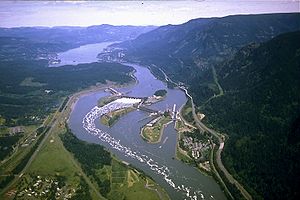How to fund a six million dollar project: Council seeks approval for Columbia Ave rebuild borrowing plan
Our downtown core’s century-old infrastructure may soon be getting an upgrade and a facelift to the tune of an estimated six million dollar Columbia Avenue rebuild project if the public agrees with the city’s proposed borrowing process.
That said, the project, originally slated for 2010, will now likely be bumped to the summer of 2012.
Initially the province’s Ministry of Transportation contacted Rossland to notify them they would be re-paving Columbia Avenue (a provincial highway) in 2010. In an effort to take advantage of the efficiencies and opportunities granted by this re-paving, the City was able to secure a delay in the paving project to determine the feasibility of upgrading its underground services. In addition to upgrading and replacing the near 100 year old infrastructure, the opportunity for above ground amenity upgrades to the downtown core also presented themselves.
Over the past year, the City held a series of design charettes designed to gain public input into potential redesigns that would make the street more aesthetically appealing, safer, more pedestrian friendly and potentially reduce green house gas emissions.
The total estimated cost of the project has been set at six million dollars. To fund the project the City is looking at borrowing over a 15 year period. Any borrowing over a period great than five years requires approval from the public. Therefore, to gain that approval, the City will soon be initiating an alternate approval process (AAP) as they did last January for the arena roof project.
Rather than holding a referendum on the issue (which generally takes significantly more time and has greater associated costs) the AAPis designed to achieve a similar result: granting the city public approval for the project’s financing process. The AAP is designed to provide information on the project and the proposed source and method of financing.
Different from a referendum or petition, an AAP first determines the number of electors in town and then, over a period of 30 days, allows residents to sign their names if they oppose the borrowing project. It is important to keep in mind that the AAP is intended to gauge interest in the funding mechanism proposed rather than the project itself.
This past Monday, council passed a motion setting the number of electors at 2,468 (based on the 2008 voting lists). This number is important: if 10% or more of residents oppose the borrowing mechanism, then council must either abandon the financing plan (which would most likely mean abandoning the project as a whole) or put the issue to a full referendum.
The period for registering you input at city hall on the AAP will end as of 4:00 PM on February 10, 2011.
Due to the timing of the AAP, the Columbia Avenue project will not be able to take place over the summer of 2011. The City has been working closely with the MOT on the project and has requested to delay the paving to the summer of 2012.
“We would have needed the APP approved by September 2010 in order to be ready for construction this summer,” explained CAO Victor Kumar. “Paving is the last part of the project. A lot of work will commence in 2011. There is engineering and other things we have to do. The Ministry needs the engineering, so they will delay until we have our approval and engineering in place.”
The work to take place if and when the funding is approved includes surface work constituting new sidewalks, curbs and gutters. The asphalt on Columbia Avenue will be covered by the MOT; however, 11,700 square meters of asphalt will be needed for Washington Street. Below the surface, new water works, sanitary sewer and storm water systems will be installed.
The total estimate cost of six million dollar is used as a worst case figure that the city cannot borrow above. Of that six million, the City plans to contribute one million from its reserves. In addition, a $330,000 grant has already been secured from the province’s Town’s for Tomorrow program. Two other grants are currently being applied for, with total contributions from the province and grants expected to total $730,000. The 15 year loan is expected to total $4,270,000 or less.
How much will the proposed borrowing method cost Rosslanders? In a worst case scenario of borrowing the entire six million over 15 years, the cost to an average Rossland home valued at $250,000 would be just under $21/month, or $251 annually. If, as expected, the City borrows only $4.5 million, the average Rossland home would pay $16 a month or $188 in additional property taxes.
These rates are, of course, applicable only if the City decides to fund the project solely through tax increases. Other options could include cutting City staff or services to offset a portion of the additional burden on tax payers. If, for example, the city reduced one senior manager and saved roughly $150,000 per year, the impact on taxpayers would be reduced to $11 per month on an average home.
If the project goes ahead in the summer of 2012 tax increases would begin in the 2012/2013 fiscal year.
Council unanimously supported moving ahead with the AAP project.
“I’m hopeful that the public will recognize the importance of us making sure we fix up the infrastructure below that street before MOT paves it,” commented Councillor Kathy Wallace. “I would hate to see beautiful fresh pavement put down and a month later we dig it up to take care of something going on below.”
Councillor Andy Stradling echoed Wallace’s sentiment, noting that along with the infrastructure works, the City’s downtown could use a facelift.
“Quite frankly, our town is starting to look a little bit shabby. The comments are not just from residents but also from those passing through. I think this is starting to impact on the marketability of our city and the attraction for people to come to our community as tourists or potential residents and businesses…I’ll be voting in favour o this motion and hope we don’t come anywhere near the six million dollar mark.”


























